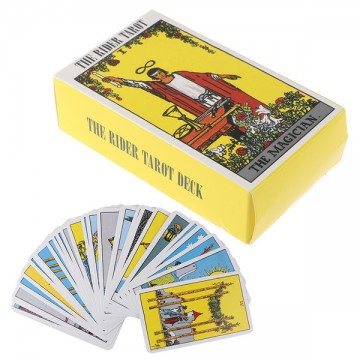The Rider Tarot Deck. Disse kort blev tegnet i 1909 af Pamela Colman Smith under vejledning af Arthur Edward Waite. Det unikke ved Rider-Waite sættet og en af de største årsager til dets enorme popularitet er, at alle kortene, inklusiv den lille arkana, viser scener med figurer og symboler. Før Rider-Waite sættet viste den lille arkana i næsten alle tarot-sæt kun antallet af ’’kulørens’’ tegn (f.eks. 10 sværd svarende til Spar 10 i spillekort). De illustrerede scener i Rider-Waite sættet gør det muligt at tolke og forstå kortene uden nødvendigvis at skulle konsultere en bog. Rider-Waite sættet er siden blevet modellen, de fleste nyere tarot-sæt er bygget op omkring. Rider-Waite Tarot blev valgt blandt Top Ti Tarot Sæt af Alle Tider på Aeclectic Tarot Forum. Pamela Colman Smith blev født 16. februar 1878 i Middlesex, England, af amerikanske forældre. Hendes barndomsår foregik i hhv. London, New York og Kingston, Jamaica. Som teenager rejste hun rundt i England med et teater ejet af Ellen Terry og Henry Irving. Derefter begyndte hun på en kunst-uddannelse som hun færdiggjorde i 1897. Hun vendte hjem til England, hvor hun blev designer for miniature teatre og illustrator – hovedsageligt af bøger, foldere og plakater. Omkring 1903 sluttede hun sig til det Gyldne Daggrys Orden (Order of the Golden Dawn) og i 1909 indvilgede hun i at male 78 tarotkort under vejledning af Arthur Edward Waite. Sættet blev udgivet samme år af William Rider and Son. Arthur Edward Waite blev født i Amerika i 1857 men blev katolsk opdraget og uddannet i England. Som 21-årig begyndte Waite at forske i og skrive om psykiske og esoteriske emner. Kort efter at have sluttet sig til det Gyldne Daggrys Orden blev han Stormester og ændrede ordenens fokus fra magi til mysticisme. Den Gyldne Daggrys Orden, hvis strukturelle hierarki byggede på Kabbalaen, bliver betragtet som det 20. århundredes største indflydelse på det okkulte. Waite var en produktiv forfatter af okkulte tekster, værker om den Hellige Gral og hele rammen for den mystiske viden, der er basis for nutidens tarot. Han er bedst kendt som medskaber af Rider-Waite Tarot og som forfatter til den tilhørende bog The Pictorial Key to the Tarot, som blev udgivet i 1910. Sprog: Engelsk Antal: 78 kort Mål: 70×120 mm Rider Waite booklet: Dr. Arthur Edward Waite (1857-1942) was a genuine scholar of occultism whose published works include The Holy Kabbalah and The Key to the Tarot first issued in England in 1910. Waite utilized symbolism as the key to the Tarot pack. In The Key to the Tarot he writes: “The true Tarot is symbolism; it speaks no other language and offers no other signs.” What are the Tarot cards about which Waite so skillfully writes? What is the message of each card and when and where did these fascinating cardboard symbols first originate? The precise origin of Tarot cards in antiquity remains obscure. Court de Gebelin writing in Le Monde Primitif in 1781 advances the theory that Tarot cards derived from an ancient Egyptian book, The Book of Thoth. Thoth was the Egyptian Mercury, said to be one of the early Kings and the inventor of the hieroglyphic system. Gebelin asserts that it is from the Egyptians and Gypsies that Tarot cards were dispersed throughout Europe. The emergence of Tarot cards in Europe predates by over five centuries the work of Waite. A German monk, Johannes, describes a game called Ludas Cartarum played in the year 1377. Covelluzzo, a fifteenth-century chronicler, relates the introduction into Viterbo of the game of cards in the year 1379. In the year 1369 playing cards are not mentioned in a decree issued by Charles VI of France against various forms of gambling; however, 28 years later, the Prevot of Paris, in an ordinance dated January 22, 1397, forbids working people from playing tennis, ball, cards, or ninepins excepting only on holidays. It is generally accepted that playing cards emerged in Europe in the latter half of the fourteenth century, probably first in Italy as a complete 78-card deck — or some inventive genius subsequently combined the common 56 cards known as the Minor Arcana with the 22 esoteric and emblematic Tarot cards known as the Major Arcana to form the 78-card pack. During the fifteenth century Tarot cards were generally drawn or hand painted for the princely houses of Northern Italy and France. Subsequently, the card packs became more numerous because they were reproduced by techniques using woodcuts, stencils and copper engraving. By the sixteenth century a modified Tarot pack called the Tarot of Marseilles gained popularity. There exists today, in the archives of the Bibliotheque Nationale in Paris, 17 Major Arcana cards generally believed, probably erroneously, to have been hand painted about the year 1392 by Jacquemin Gringonneur for Charles VI of France. These cards are likely of later Venetian origin, possibly mid-fifteenth-century Tarocchi of Venice cards.
Tarot – Rider-Waite – Orakelkort og Englekort på engelsk – GodKarmaShop
159,00 kr.
Related products
Orakelkort og Englekort på engelsk
Light Seer's Tarot Card – Chris-Anne – Orakelkort og Englekort på engelsk – GodKarmaShop
Orakelkort og Englekort på engelsk
Oracle of the 7 Energies – Colette Baron-Reid – Orakelkort og Englekort på engelsk – GodKarmaShop
Orakelkort og Englekort på engelsk
Super Attractor Cards – Gabrielle Bernstein – Orakelkort og Englekort på engelsk – GodKarmaShop
Orakelkort og Englekort på engelsk
Orakelkort og Englekort på engelsk
Moonology Oracle Cards – Yasmin Boland – Orakelkort og Englekort på engelsk – GodKarmaShop
Orakelkort og Englekort på engelsk
The flower of life kort – Orakelkort og Englekort på engelsk – GodKarmaShop
Orakelkort og Englekort på engelsk
Tarot – Original 1909 – Orakelkort og Englekort på engelsk – GodKarmaShop
Orakelkort og Englekort på engelsk
The tree of life oracle – Orakelkort og Englekort på engelsk – GodKarmaShop










